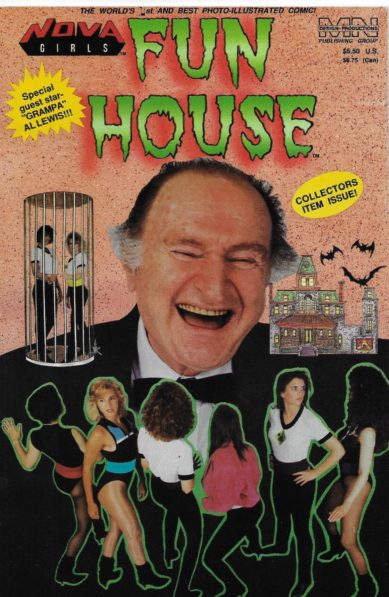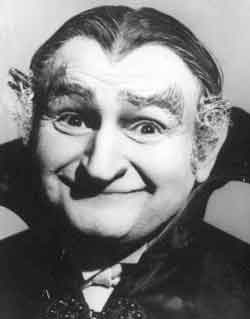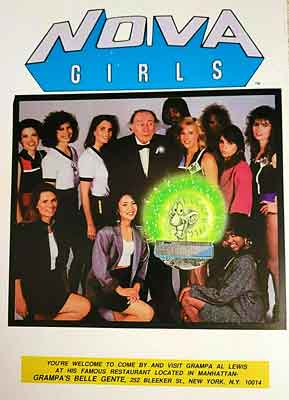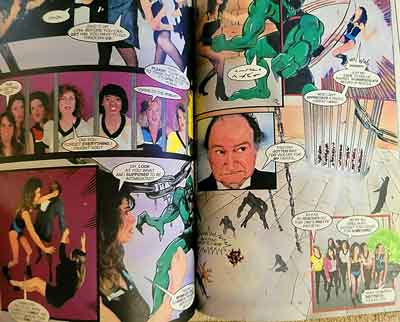 By MARIANO NICIEZA, SCOTT LOBDELL, THOM O’CONNOR (NM Design Productions; 1991)
By MARIANO NICIEZA, SCOTT LOBDELL, THOM O’CONNOR (NM Design Productions; 1991)
Who the Hell are the “Nova Girls?” I didn’t know before reading this comic book they headline, and after perusing it I’m still not sure. I do, however, know of the late Al Lewis (1923-2006), the journeyman actor best known for playing Grampa on THE MUNSTERS in 1964-66, which branded him forevermore as “Grampa Al.” Both the Nova Girls and Mr. Lewis appear in this, a rare example of an American made photo illustrated comic.
Photo comics have been proven quite popular in Europe and South America, but never really caught on in the US (hence the erroneous claim, made on the cover, that this is “The World’s First” such comic). They tend to be considered “lazy” by American comic book readers and publishers, although I believe there’s another reason they’re shunned—quite simply, most American photo comics flat-out suck. Case in point: NOVA GIRLS FUN HOUSE.
The Nova Girls consist, apparently, of eight women, all sporting very 1980s-centric outfits and hairstyles, living in the 50th Century. These gals headlined two previous comics (which based on what I’ve heard weren’t much better than this one), thus explaining, in part, the disjointed nature of the narrative, with its constant references to past events.
 But anyway: the girls meet up with Grampa Al, who’s travelled forward in time from the late twentieth century (his explanation: “Didn’t you hear of syndication?”). He imprisons them in a funhouse, each room of which has different physical properties and various threats (giant insects, etc.) from which the gals always manage to extricate themselves, usually with a lot of crudely rendered punching and kicking.
But anyway: the girls meet up with Grampa Al, who’s travelled forward in time from the late twentieth century (his explanation: “Didn’t you hear of syndication?”). He imprisons them in a funhouse, each room of which has different physical properties and various threats (giant insects, etc.) from which the gals always manage to extricate themselves, usually with a lot of crudely rendered punching and kicking.
This comic was scripted by Scott Lobdell, who has a number of legitimate mainstream credits to his name (including X-MEN and SUPERMAN). He was admittedly at the beginning of his career when he wrote NOVA GIRLS FUNHOUSE, but that doesn’t excuse the severely disjointed storytelling—which incorporates time travel and hallucinations, as when toward the end one of Nova Girls is revealed to be dreaming her 50th Century existence while in a coma in the 20th Century—nor the overall tone, which is about on the level of a MAD TV skit.
The chief problem is with the photographic visuals. From a distance they’re quite striking and bizarre, but up close reveal a lot of missed eye lines, ill-proportioned compositing and facial expressions that rarely match the situations in which the characters find themselves. It certainly doesn’t help matters that the quality of the artwork into which the flesh and blood performers have been inserted is mediocre at best; the European and South American photo comic model, which tends to utilize actual scenery, works much better than the composite approach taken here (further explaining why photo comics haven’t taken off in America).
As for Grampa Al, he does very little outside emitting some horrendous self-referential puns (“The only thing I like less than melodrama is when they update sixties television shows with a new cast!”) and plugging the NYC Italian restaurant he owned (pictures of which are incorporated into the comic, and the address provided on the back cover). NOVA GIRLS FUN HOUSE, you’ll find, doesn’t appear on too many of Mr. Lewis’ (or Lobdell’s) resumes, and there’s a reason for that.


